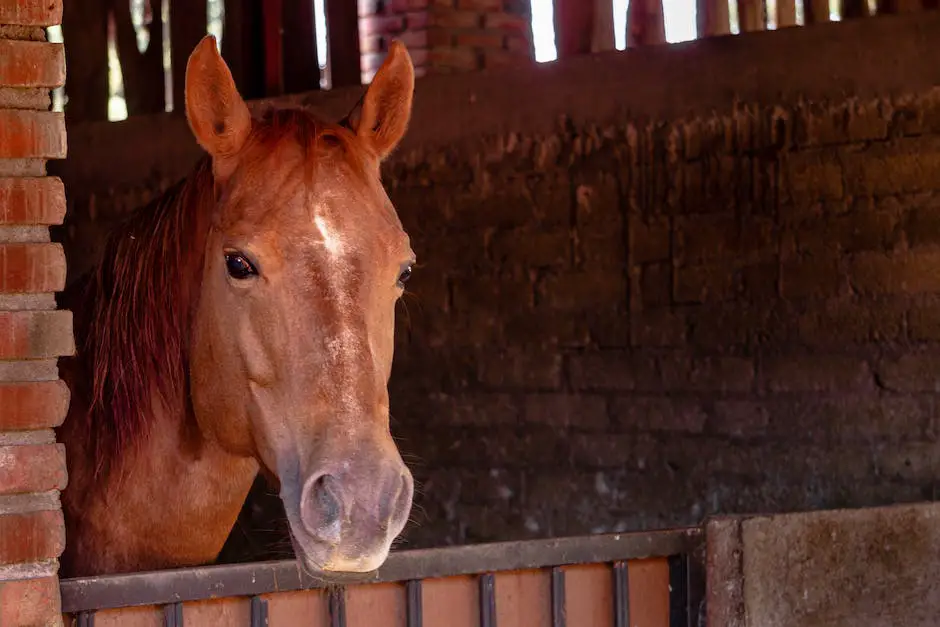In the equestrian world, maintaining the comfort and health of your horse necessitates an understanding of its physiological needs. A critical aspect of this is learning to manage your horse’s body temperature, particularly if it is naturally “cold-blooded”. This term, while not a reflection of a horse’s actual blood temperature like reptiles, typically refers to specific breeds or individuals that are slow to warm up and/or have difficulty maintaining their internal heat when the temperature drops. This essay offers an in-depth exploration of ways to effectively warm a cold-blooded horse. We will delve into the ways in which understanding a horse’s normal body temperature, the proper use of horse blankets and rugs, and subtle adjustments to your horse’s diet can together ensure your horse remains comfortable and healthy all year.
Table of Contents (Horspedia)
Understanding Horse’s Normal Body Temperature
Galloping Through Thermometers: Understanding and Measuring Your Horse’s Normal Temperature
All horse enthusiasts will agree: monitoring the health of our beloved equine companions is crucial. Today, we’ll be riding down a less-talked-about trail, exploring our horse’s normal temperature range and how we can accurately measure it using a rectal thermometer -a vital instrument in anyone’s horse health kit.
A horse’s body temperature can fluctuate for several reasons, but generally, its normal temperature range is between 99 and 101.5 degrees Fahrenheit (37.2 and 38.6 degrees Celsius). However, slight variations in this range are not uncommon; some healthy horses may naturally run slightly cooler or warmer.
To measure a horse’s body temperature, consider taking the following steps:
- Preparation: Thoroughly clean a rectal thermometer using warm soapy water, or better yet, a disinfectant. For safety and ease, consider using a digital rectal thermometer with a flexible tip.
- Step 1: Lubricate: Next, lubricate the thermometer with a small amount of lubricating jelly. This is to ensure a smoother and safer insertion.
- Step 2: Positioning: Approach the horse from the side to avoid getting kicked accidentally. Raise its tail gently and expose the rectum.
- Step 3: Insertion: Now, gently insert the lubricated thermometer into the rectum, approximately two to three inches deep. For rectal thermometers with a ring on the end, a piece of string can be tied to it. This string ensures the thermometer is easy to retrieve and prevents it from being lost in the rectum.
- Step 4: Wait for Reading: Wait for the thermometer to record the temperature. Most digital thermometers will beep when the reading is complete, typically within 1-2 minutes.
- Step 5: Clean Up: After reading the temperature, gently remove the thermometer and clean it again with warm soapy water or disinfectant.
With familiarity and routine, taking the horse’s temperature can become as second nature as saddling up for a ride. It’s a critical part of maintaining the horse’s health and understanding any changes that might need a vet’s attention.
As countlessly repeated in the equestrian world, every horse is an individual. Just as our equestrian partners’ personalities can vary, so too can their ‘normal’ temperatures. It’s helpful to take several baseline readings when the horse is healthy to establish its unique temperature range.
Remember, always consult your veterinarian if you notice any drastic or consistent changes in your horse’s body temperature. Now, let’s saddle up and ride into a horizon filled with healthier and happier horses!

Using Horse Blankets and Rugs
Ensuring Equine Comfort: The Impact of Horse Blankets and Rugs in Warming Cold Blooded Horses
In the domain of Equine health, a topic often overlooked is the importance of regulating a horse’s body temperature, especially for cold-blooded horses. One significant aspect of this is the usage of horse blankets and rugs. While many may see these equestrian accessories as stylish add-ons, they indeed serve a more pressing and functional purpose – warming up your equine friend.
Cold-blooded horses, also known as draft horses, have a considerable body mass, which enables them to endure colder temperatures better than their hot-blooded or warm-blooded counterparts. However, they still need assistance in maintaining their body temperature during colder weather or changing seasons. Here is where horse blankets and rugs come into play.
Horse blankets and rugs are specifically designed to provide warmth to horses. The varied materials and thickness contribute to trap body heat and protect the body against chilly and uncomfortable weather conditions. The heat captured by the blanket or rug helps maintain the horse’s body warmth, preventing any potential health issues associated with fluctuating body temperature.
Blankets and rugs are made in different sizes, weights, and designs to adhere to the needs of various horse breeds, sizes, and climates. Furthermore, they’re also designed to be breathable, which allows for ample ventilation and ensures your horse doesn’t overheat. This is crucial for creating a balanced, comfort-centric climate for your horse.
In contrast to human attire, horse blankets and rugs are not just for protection from cold weather. Summer sheets are thinner, lightweight versions of their winter counterparts, providing protection against sunburn and bugs, while also helping to regulate their body temperature.
Given the wide range of blankets and rugs available, it’s integral to choose the right type for your horse’s needs. For example, turnout blankets or rugs are perfect for horses that spend more time outdoors, offering waterproof features. Stable blankets are not waterproof but are designed to provide warmth while the horse is indoors.
Blanketing isn’t compulsory for all horses; some have natural defenses against the cold, such as growing a thick winter coat. However, for horses that are not acclimated to colder climates or are shaven, blankets can be a lifesaver. Be mindful that a horse’s warmth requirement may change with age, health, and weather, so adjustments should be made proactively.
Maintenance of blankets and rugs is also key. Regular cleaning and inspection are crucial to ensure they remain in prime shape, providing the maximum warming effect for your horse. Damaged or dirty blankets can become uncomfortable, diminishing the overall insulation they provide and potentially causing skin irritations or disease.
Let’s always remember, horse blankets and rugs are more than just equine fashion statements. They serve a significant role in ensuring your horse maintains a steady, comfortable body temperature, thus promoting overall health and well-being. So, take that extra step to protect your cold-blooded companion against Mother Nature’s elements by investing in the right blanket or rug. It’s a small price to pay for the wellness of your beloved equine friend!

Adjusting Horse’s Diet
As we plunge deeper into the colder months, equestrian hobbyists must understand the critical role of equine nutrition in maintaining the warmth of our hooved friends. Indeed, a horse’s diet plays an important part in helping them generate internal heat and maintain a stable body temperature even in harsh weather conditions. So, if you’re looking to ensure the warmth of your horse this winter, here are some changes in diet that you can consider.
Given that the process of digestion creates heat, one straightforward way to help your horse keep warm is through the provision of good quality roughage. Seriously consider hay, the “unsung hero” of equine diets, which can be incredibly beneficial to provide warmth as it ferments longer in the horse’s gut, creating sustained heat. Alfalfa hay, in particular, is rich in calories and digestible fiber necessary for internal heat generation.
Boosting your horse’s grain intake could also be a consideration. A grain feed, such as oats, barley, or corn, provides the necessary energy that helps horses generate heat internally. The nutrition doesn’t stop here, however. Certain oils, like flaxseed and soybean oil, can provide a calorie-dense supplement to support your horse’s energy need without overloading their digestive system.
Water, while often left out of the diet conversation, plays an essential role in maintaining a horse’s body warmth. As horses generate heat through the digestive process, they need an ample supply of water to avoid dehydration and aid digestion. Do remember, however, to offer lukewarm water instead of cold to encourage intake during chillier days.
Of course, dietary changes should always be made gradually to allow the horse’s digestive system to adjust. Essential minerals and vitamins should also not be overlooked. Supplements containing essential fatty acids, vitamin E and selenium can support immune function and aid in temperature regulation, providing a little extra support during the colder months.
Horses’ energy requirements increase during colder months to fend off the cold. Thus, your horse’s diet should be aptly increased to match this extra demand. You may want to consult with a professional equine nutritionist or your veterinarian to determine the best diet adjustments for your specific horse breed, age, health status, and climate.
Finally, let’s not forget the importance of monitoring your horse’s weight and body condition regularly. Significant weight loss could suggest an inadequate diet and may leave your horse feeling the cold more. Body scoring and regular veterinary checks will guide you on the necessary diet adjustments.
Remember, diet regulation is not merely about keeping your horse warm but also about preserving their overall health and vitality during the colder months. By making necessary nutritional adjustments, you’ll be contributing greatly to your horse’s warmth and well-being. Bundle up and keep your hooved friends healthy, because winter is at the gates!

Our journey through understanding a horse’s body temperature fluctuations, the use of horse rugs and blankets, and dietary adjustments for optimum heat production gives us a comprehensive approach to warming a cold-blooded horse. It underscores the crucial role intertwined nature of knowledge, care, and observance in maintaining a horse’s comfortable body temperature. Whether you are an enthusiast or a hobbyist, this knowledge equips you with an additional layer of complexity in your equestrian skills. By consistently applying these learned techniques, not only can you enhance your horse’s comfort and health but also deepen your connection with your equine companion, accentuating the joys of equine care and companionship.
